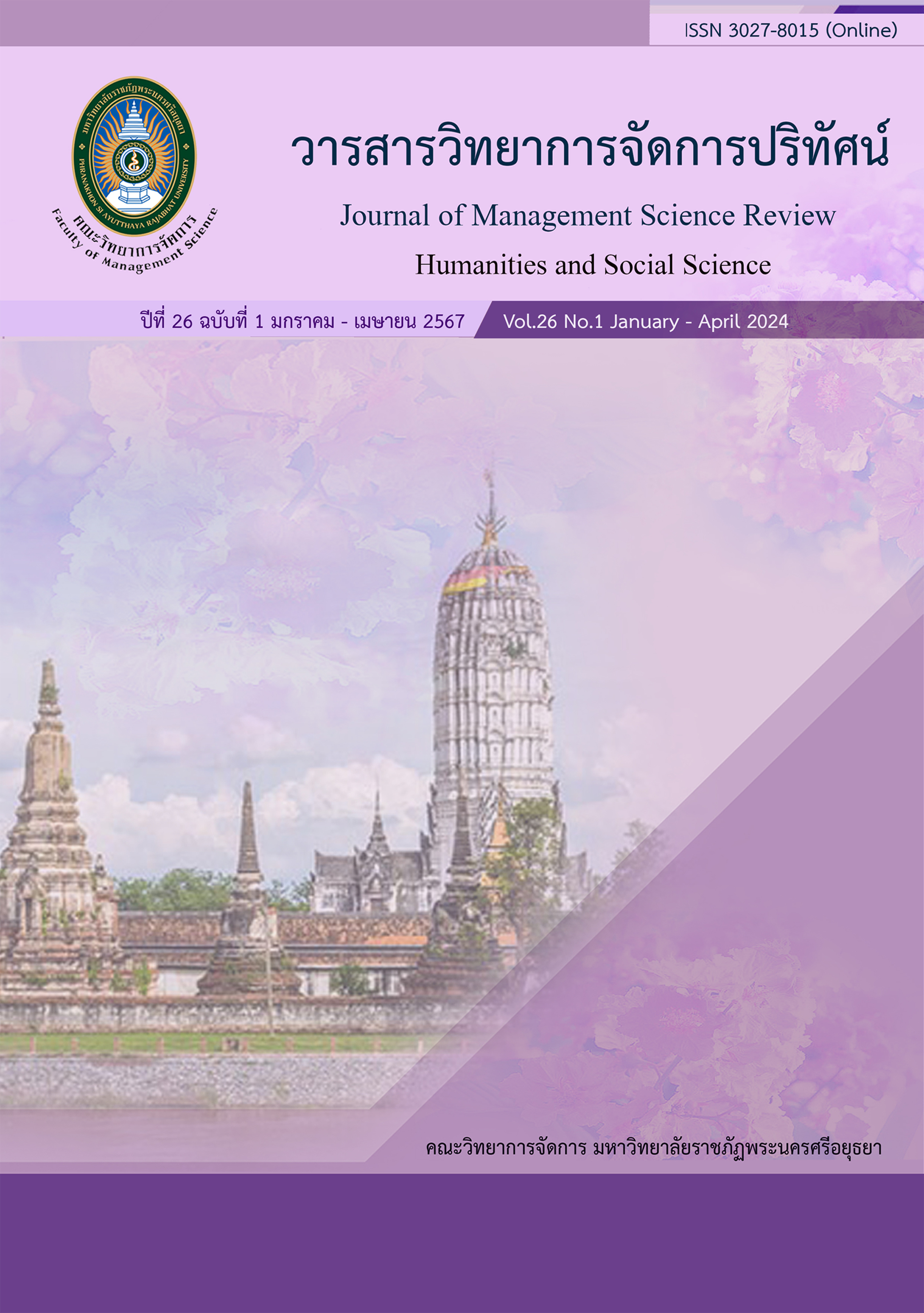Guidelines for Public Space Management of Ban Dong Yang Thai, Nong Naen Subdistrict, Phanom Sarakham District, Chachoengsao Province
Keywords:
Management, Public Space, Ban Dong Yang Thai CommunityAbstract
The purpose of the research was to study current public space usage, problems and needs of public space usage of the community, and guidelines for public space management of Ban Dong Yang Thai, Nong Naen Subdistrict, Phanom Sarakham District, Chachoengsao province. This research was conducted as a qualitative study, employing in-depth interviews with the targeted population groups, namely the residents of the Ban Dong Yang Thai community. This population comprised (1) 5 people aged between 5-17 years, (2) 5 people aged between 18-64 years, and (3) 5 people aged 65 years and above. Group discussions were conducted with key informants, including (1) 3 community representatives from the Ban Dong Yang Thai community, (2) 5 community leaders and committee members from the Ban Dong Yang Thai community, and (3) 2 representatives from the Nong Naen Subdistrict Administrative Organization. Content analysis and data grouping were performed to derive conclusions and present them following the research objectives.
The study's findings revealed that Ban Dong Yang Thai's current public spaces, including the Dong Yang temple, Nong Naen Wittaya School, Nong Naen Subdistrict Administrative Organization, Nong Haen Health Station or Nong Haen Subdistrict Health Promoting Hospital, Ban Dong Yang Thai Headman's House, and the house of a council member of the Nong Naen Subdistrict Administrative Organization, were utilized for personal, family, and community activities. All areas and land in Ban Dong Yang Thai were owned or legally possessed; they were never utilized and remained abandoned or flooded. Sometimes there was a gathering of teenagers in the area. Garbage was dumped, and it was the home of various animals that were dangerous to the villagers. Villagers used the areas as walkways which can be regarded as an invasion of personal space. Members of the Ban Dong Yang Thai community still desired a central area of the village or subdistrict for daily activities by the community's way of life, which included personal activities and public events involving members of the community and neighboring communities following the way of life they formerly practiced. The PAB Model, which consisted of P (engagement) community engagement, A (Administration) management, and B (Budget) budget, served as guidelines for managing public places in the Ban Dong Yang Thai Community, Nong Naen Subdistrict, and Phanom Sarakham District of Chachoengsao Province.
References
Bibri, S. E. (2020). Compact urbanism and the synergic potential of its integration with data-driven
smart urbanism: An extensive interdisciplinary literature review. Land Use Policy, 97.
doi:10.1016/j.landusepol.2020.104703
Brill, T. (2020). How Does Stress Shape Experience and Perceptions in Public Space?. [Doctoral Dissertation]. The Ohio State University, United State of America.
Chaichan S. & Laiprakobsap N. (2016). Public Concepts of Urban Public Space. Built Environment Inquiry, 15(2), 71-83.
Chaiyawan, S., & Prathuengboriboon, N. (2017). Good health project by changing lifestyle to production system. Alternative agriculture of Ban Huai Sai Suksawat community, Huai Yap Subdistrict, Banthi District, Lamphun Province. (Report edition Somboon). Thailand Research Fund.
Garau, E., Torralba, M., & Pueyo-Ros, J. (2021). What is a river basin? Assessing and understandingthe sociocultural mental constructs of landscapes from different stakeholders across a river basin. Landscape and Urban Planning, 214. doi:10.1016/j.landurbplan.2021.104192
Gordon, R., Rose, D. M., & Bushel, H. (2009). Testing planning organizing, leading and controlling (POLC): an empirical examination of the functions of management through a pilot study developing the 'POLC-BMS'. In Proceedings of the 23rd Australian and New Zealand Academy of Management Conference (ANZAM 2009).
Hill-Dixon, A., Solley, S., & Bynon, R. (2018). Being Well Together: The creation of the Co-op Community Wellbeing Index. The Young Foundation, Coop, Geolytix.
Jino, T., Tammikakul, P., & Sutthikunchon, P. (2021). Public space development for community empowerment: a case study of San Pa Pao, Chiang Mai. Journal of Environmental Design, 8(1), 60-77.
Kanthamuangli, A. (2019). What exactly is public space. Retrieved October 1, 2023, from https://theurbanis.com/public-realm/
Kongpunphin, C., & Iamtrakul, P. (2018). Changing the role of public spaces in Thailand. Academic Journal of the Faculty of Architecture, KMITL, 26(1), 30-40.
Kotchasee, K., & Anukulyudhathon, E. (2019). Dimension Application of public space usage and the role of traditional community in Chiang Mai City. Rajabhat Chiang Mai Research Journal, 20(1),5-18.
Lloyd, K., & Auld, C. (2003). Leisure, public space and quality of life in the urban environment. Urban policy and research, 21(4), 339-356.
Paxson, L. (2007). Toward a theory of contestation in Public Space. New York: The City University of New York.
Phaksukcharoen, K. (2008). Energy-saving shortcuts: small public open spaces - social spaces of Thai communities. Bangkok: Chulalongkorn University.
Phukongchai, W., Sutthisai, W., Soonthorn, S., & Noicharioen, P. (2022). Public Land Management on Community Participation Model in Maha Sarakham Province. Journal of Modern Learning Development, 7(6), 12-29.
Pongsawat, A. (2018). Cultural and historical area management: a case study of Bangkok’s Pom Mahakan Community. [Master’s Thesis]. Thammasat University.
Xiao, J., & Hilton, A. (2019). An investigation of soundscape factors influencing perceptions of square dancing in urban streets: a case study in a county level city in China. International journal of environmental research and public health, 16(5), 840.





